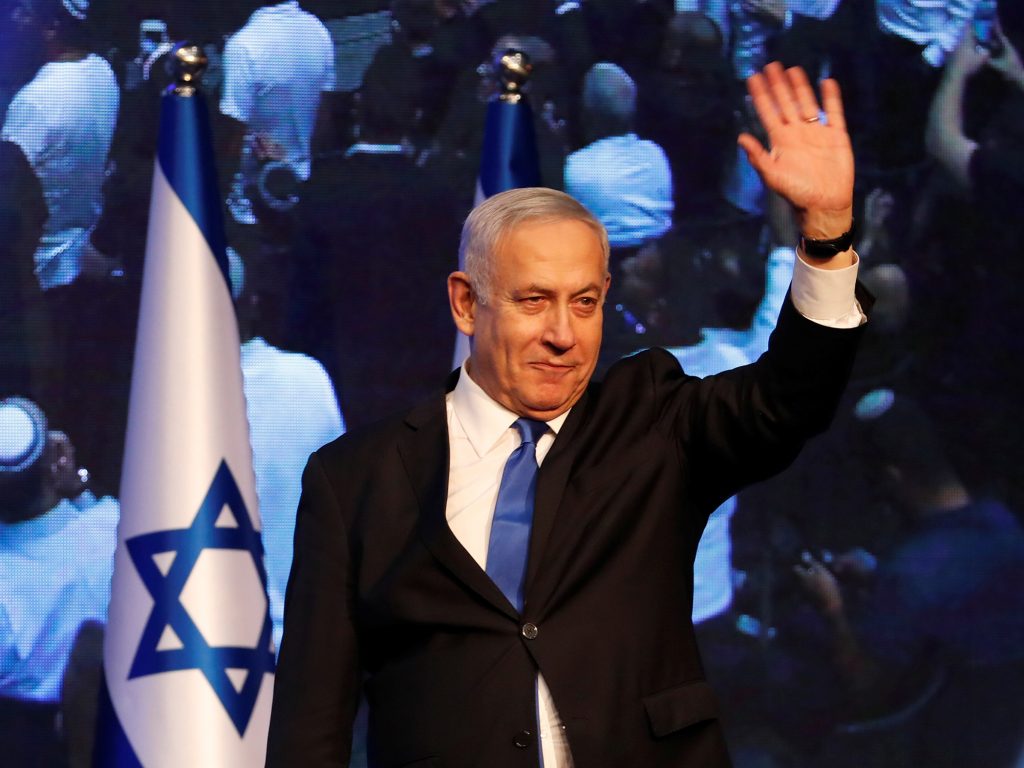
Israeli Prime Minister Benjamin Netanyahu arrives at the Likud party headquarters following the announcement of exit polls during Israel's parliamentary election in Tel Aviv, Israel September 18, 2019. REUTERS/Ammar Awad
Israel’s
raucous election season—culminating in the country’s second ballot in under six
months—ended on September 17. Results were disappointing for the incumbent,
Prime Minister Benjamin Netanyahu, but still inconclusive. The next phase,
during which the parties to the 22nd Knesset will “slam
dance” their way to a new coalition government (or alternatively, to a
third vote), promises to be no less tortuous. And with the Jewish High Holidays
beginning in short order, the process could extend potentially for months.
The
fitful campaign began sluggishly, with the Israeli public suffering from
political fatigue and more interested in their summer vacations, before picking
up steam in September. Issues of religion and state—most specifically, disputes
surrounding legislation to draft Ultra-Orthodox Jews into the Israel Defense Forces—catalyzed
the spiral which sent Israelis back to the polls, but in the home stretch, the
frame would shift at whiplash-inducing speed.
Disclosures
of secret Iranian nuclear weapons facilities, promises
of extending Israeli sovereignty to West Bank settlements, warnings
of imminent military operations in Gaza, and reports
of a mutual defense treaty with the United States were among the features of
Netanyahu’s bid to seize the narrative. Hovering over the entire discourse was
the fundamental question of whether Netanyahu himself should be granted another
term in office.
Numbers
remain the key to unlocking victory. Parties engaged between themselves in a
series of mergers and acquisitions in the hopes of preventing their possible descent
below the 3.25% electoral threshold—which would result in their votes being
discarded entirely and thus, lost to their host Right or Left bloc. The
far-right Jewish Power party, which ran alone, appears
so far to be the only faction to have suffered this fate. Emergency meetings
which almost all parties convened late on election day to bring out the vote
were rewarded
by unexpectedly high voter turnout of 69.4%—a 1.5% increase from April. Final
tallies are days away and will dictate the way forward, but the horse-trading
begins now.
Politicians
and pundits are already pondering the terms of Netanyahu’s
“surrender,” but no candidate can craft an obvious path to power. Exit
polls, notorious for their inaccuracy, might yet prove wrong in their
indications of Netanyahu’s demise. Meanwhile, Benny Gantz, leader of the Blue
and White party which may capture the largest vote count, has stated
explicitly that he would prefer to join a national unity government with
Netanyahu’s Likud party—but only if Netanyahu, facing indictment on corruption
charges, is deposed as prime minister. (Netanyahu will be loath to concede
defeat and face his impending hearing
with Attorney-General Avichai Mandelblit as a private citizen.) Avigdor
Liberman, head of the Israel Our Home party and presumed kingmaker, has
declared that he will join only a unity government that excludes
religious parties. Cobbling together a ruling majority—as opposed to more
attainable blocking majorities—will be excruciatingly difficult under these
circumstances and preconditions.
The
next move belongs to President Reuven Rivlin, who will soon summon
representatives of the parties and solicit their recommendations for Israel’s
next prime minister. Rivlin has discretionary authority to nominate a candidate
to this task, but is bound conventionally to favor the Knesset member with the
best chance of succeeding at building a coalition. This procedure could evolve in
any number of ways.
Original
expectations of a Netanyahu triumph foresaw members of Blue and White enticed
to peel off from their mothership and join a Likud administration. That seems
unlikely now, given the apparent outcome of the voting. With the tables turned,
senior Likud officials could be the ones who have to decide whether to rally
behind Netanyahu or to try unseating him and making a deal with Gantz. Whether the
Joint Arab List—which one poll has forecasted as winning fifteen seats in
parliament, and whose leader, Ayman Odeh could become conceivably its opposition
leader—taps Gantz to form a government or makes no (or another) endorsement
could also impact on Rivlin’s calculus.
No
matter how this plays out, the coming period does not bode well for stability
in a deeply divided Israel. Almost any coalition—with the exception possibly of
a rotation agreement between the two anchor parties—that might emerge will be
inherently fragile with disparate interests pulling in different directions.
And although President Rivlin has pledged to leverage the full force of his
office to avoid
a repeat election, political dynamics could even ordain a third ballot if
parties refuse to show flexibility and make compromises on their demands.
Looming
on the horizon is US President Donald J. Trump’s Middle East peace plan which,
according to Netanyahu, will be released
“immediately” after the September 17 election. Netanyahu, whose
relationship with Trump has been exceptionally close, campaigned as the Israeli
leader best positioned to negotiate the package with Trump. That remains to be
seen, but one thing is certain: should the blueprint indeed be published at
this time, it would inject a whole new level of volatility into an Israeli body
politic that is already in turmoil.
Shalom Lipner is a nonresident senior fellow for Middle East Programs at the Atlantic Council. Follow him on Twitter @ShalomLipner.
Results were disappointing for the incumbent, Prime Minister Benjamin Netanyahu, but still inconclusive. The next phase promises to be no less tortuous.
|